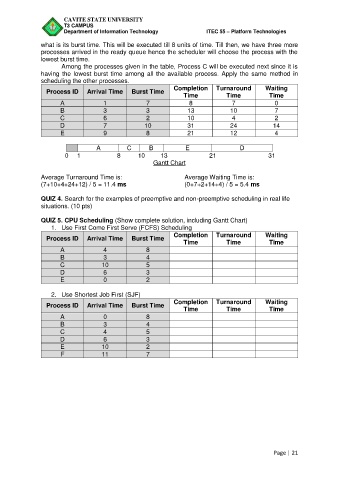Page 141 - PowerPoint Presentation
P. 141
CAVITE STATE UNIVERSITY
T3 CAMPUS
Department of Information Technology ITEC 55 – Platform Technologies
what is its burst time. This will be executed till 8 units of time. Till then, we have three more
processes arrived in the ready queue hence the scheduler will choose the process with the
lowest burst time.
Among the processes given in the table, Process C will be executed next since it is
having the lowest burst time among all the available process. Apply the same method in
scheduling the other processes.
Completion Turnaround Waiting
Process ID Arrival Time Burst Time
Time Time Time
A 1 7 8 7 0
B 3 3 13 10 7
C 6 2 10 4 2
D 7 10 31 24 14
E 9 8 21 12 4
A C B E D
0 1 8 10 13 21 31
Gantt Chart
Average Turnaround Time is: Average Waiting Time is:
(7+10+4+24+12) / 5 = 11.4 ms (0+7+2+14+4) / 5 = 5.4 ms
QUIZ 4. Search for the examples of preemptive and non-preemptive scheduling in real life
situations. (10 pts)
QUIZ 5. CPU Scheduling (Show complete solution, including Gantt Chart)
1. Use First Come First Serve (FCFS) Scheduling
Completion Turnaround Waiting
Process ID Arrival Time Burst Time
Time Time Time
A 4 8
B 3 4
C 10 5
D 6 3
E 0 2
2. Use Shortest Job First (SJF)
Completion Turnaround Waiting
Process ID Arrival Time Burst Time
Time Time Time
A 0 8
B 3 4
C 4 5
D 6 3
E 10 2
F 11 7
Page | 21

